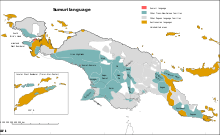Sumuri language
Sumuri or Sumeri (one of two Papuan languages also known as Tanah Merah) is a language spoken in Sumuri District, Teluk Bintuni Regency on the Bomberai Peninsula by about a thousand people.
| Sumuri | |
|---|---|
| Sumeri | |
| Tanah Merah | |
| Region | Sumuri District, Teluk Bintuni Regency, West Papua (Bapai Rover and Gondu River areas) |
Native speakers | (500 cited 1978)[1] |
| Language codes | |
| ISO 639-3 | tcm |
| Glottolog | tana1288[2] |
 Map: The Sumeri language of New Guinea (located at left, in the Bird's Head)
The Sumeri language
Other Trans–New Guinea languages
Other Papuan languages
Austronesian languages
Uninhabited | |
Classification
In the classifications of Malcolm Ross (2005) and Timothy Usher (2020), Sumeri forms an independent branch of the Trans–New Guinea family, but Palmer (2018) classifies it as a language isolate.[3] It does not fit in with any of the established branches of TNG, but based on what little data there is, it would seem to be closest to either the Berau Gulf branches (i.e. South Bird's Head, West Bomberai etc.) or the Asmat–Mombum languages and their relatives further east.
Sumeri has previously been linked to the Mairasi languages, but those do not share the TNG pronouns of Sumeri. The Sumeri pronouns are:
sg pl 1ex na-fea kiria 1in kigokomaka 2 ka-fea ki-fia
There are no 3rd-person personal pronouns, only demonstratives. The pronouns appear to reflect pTNG *na 1sg, *ga 2sg, and *gi 2pl.
See also
References
- Ross, Malcolm (2005). "Pronouns as a preliminary diagnostic for grouping Papuan languages". In Andrew Pawley; Robert Attenborough; Robin Hide; Jack Golson (eds.). Papuan pasts: cultural, linguistic and biological histories of Papuan-speaking peoples. Canberra: Pacific Linguistics. pp. 15–66. ISBN 0858835622. OCLC 67292782.
Notes
- Sumuri at Ethnologue (18th ed., 2015)
- Hammarström, Harald; Forkel, Robert; Haspelmath, Martin, eds. (2017). "Tanahmerah". Glottolog 3.0. Jena, Germany: Max Planck Institute for the Science of Human History.
- Palmer, Bill (2018). "Language families of the New Guinea Area". In Palmer, Bill (ed.). The Languages and Linguistics of the New Guinea Area: A Comprehensive Guide. The World of Linguistics. 4. Berlin: De Gruyter Mouton. pp. 1–20. ISBN 978-3-11-028642-7.